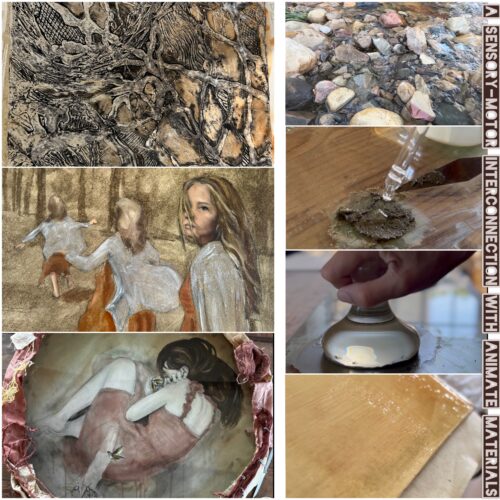
Developing ideas through making work and ‘listening’ to the work
Gwen Bird – Level One (HE4) Drawing 1: Exploring Drawing Media
That artists use sketchbooks and loose sheets of paper and backs of envelopes to develop ideas isn’t a new idea. However, it’s good to remind oneself that ‘ideas’ are not always the most important thing about a piece of work from timer to time. Often the experience of making is the priority for the artist, rather than any interpretation by some putative future audience. Second guessing what an audience might think can hobble an artist’s work and progress.
Gwen Bird’s fourth submission for Drawing 1: Exploring Drawing Media shows how developing ideas by working through material processes rather than thinking about conclusions or results can result in creative breakthroughs. While having a goal in mind is not necessarily a bad thing when making work, it can sometimes overwhelm and obscure really interesting potential ideas that emerged from the act of making.
At the start of part four, which is concerned with ‘process’ Gwen has played around with different media and carefully noted how they interact with one another and with different substrates. she’s also played around with different tools to apply ink and paint and so on. What I like is that she’s then returned to these drawings and revised and edited them by, for example, adding lines around areas of common colour. This is toughened up the drawings and made them seem less random and more authored. These might not be completed works of art or even especially impressive in grand scheme of things but what they do is capture an idea that could be used later. Noticing something – and then acting on it – is an important part of creative practice.


After making what looked like small versions of wet abstract expressionist paintings, Gwen has cut parts of the images out and collage them onto similar images. She has then added motifs from previous work to see how these different elements interact to make something new. It’s unlikely that she would have made this sort of image straight away; she needed to make one image and then take notice of what it needed. This is what we might call ’listening to the work’. That is, taking notice of how something might evolve into something else. I think we all know what it feels like to get lost in the making of work. This is a feeling that we ought to seek out and try and replicate as much as possible. Being open to improvisation and change to allow something to grow and develop in front of us is an important skill for visual artists. it’s not necessarily about executing an idea that can be written down or explained. that we sometimes feel unable to explain a piece of work might be indicative of its visual power.

Throughout the blog entries that accompany this work, Gwen reflects on how other artists might have influenced her and what the concerns of those artists were. The influence might not be obvious or direct but it’s an indication of how it can feel to be open when making work. Connections are made and things emerge. This embeds Gwen’s contextual understanding into her material investigations and creativity. Bringing context into practise can often be a challenge or seem a little artificial, but here Gwen manages to move seamlessly between her own work and thinking about the work of others.
One exciting innovation in this body of work emerges from a previous submission. In Part 3 of EDM, Gwen made sculptures of drawings and then made drawings of those sculptures. She’s kept this up in part 4. So now we have a student who is negotiating with art historical and contemporary art contexts and also allowing sculpture and drawing and painting to somehow speak to each other; each driving the other on. Again, I don’t think Gwen would have necessarily developed her work in so many different directions without allowing these elements to interact so productively. It’s almost like she’s a ringmaster or a conductor.




It’s important to say that not everything works as well as everything else, but that’s not important. Relaxing and enjoying a creative process that is generative has allowed Gwen to develop some original work that draws on but doesn’t mimic the work of others and also provides her with a lot of other avenues to explore.
I look forward to seeing what comes next…
All images by Gwen Bird and taken from her blog: https://gwensdrawings.weebly.com/part-4.html
|
|







Lovely work Gwen!
Thank you Emma. I’d like to acknowledge the guidance, enthusiasm and support from Bryan, which has enabled my work to develop throughout EDM.
Lovely to see your work and the processes along the way, very inspiring.
Great to see your work and the processes along the way, very inspiring.
Well done Gwen! It’s lovely to see how you’ve been developing your work on EDM.
Inspirational Gwen!
I love the idea of leaving work and coming back to it. I think each addition has had time to percolate in your mind and adds something extra both visually and temporarily.
The end result is beautiful